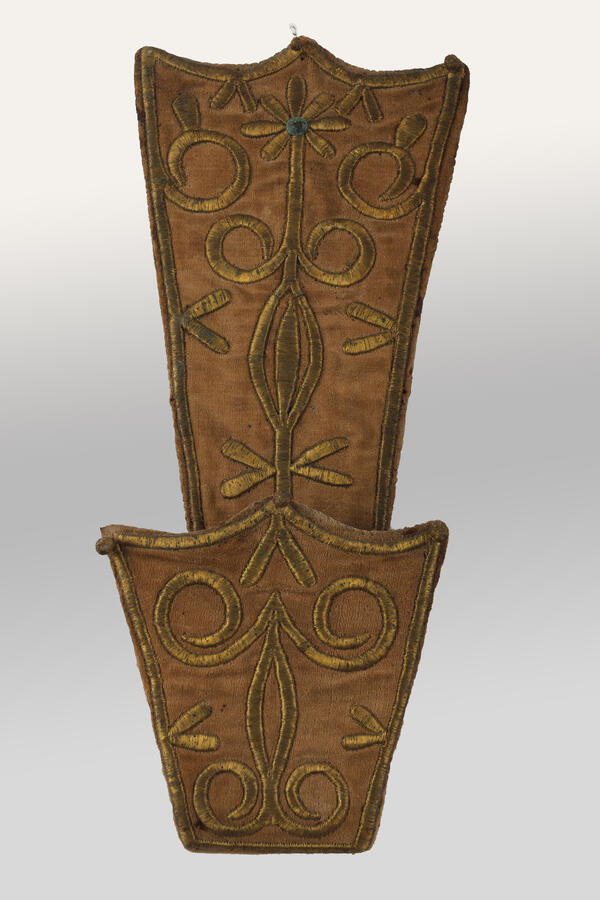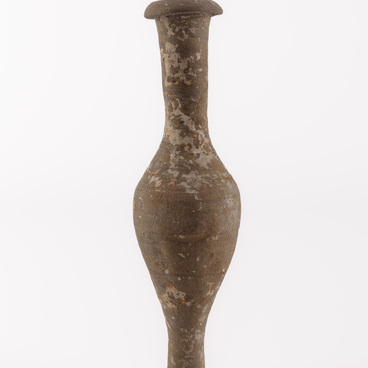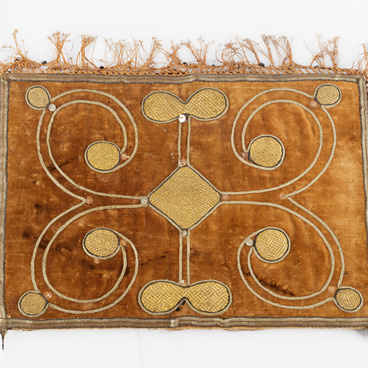The museum houses a traditional Circassian household item — a wall-mounted towel rack, richly embroidered with gold threads.
Circassian gold embroidery is one of the oldest crafts in the West Caucasus. It is distinguished by a harmonious combination of embroidery with galloons and trimmings made of gold and silver threads. Only the rich could afford such artworks. The ability to embroider with gold and silver threads, as well as weaving were considered obligatory for Circassian girls from noble families, so they began to learn these skills from early childhood. Sometimes, in order to comprehend all the subtleties and secrets of gold embroidery, girls were sent to families where there was a skilled craftswoman. They were exempted from chores, as the technique of gold embroidery required perseverance and patience. Before starting work, the girls treated their fingers with special oils so that their rough skin would not damage the finest gold or silver thread and spoil the embroidery. Girls embroidered clothes, quivers for arrows, saddles, pouches, bullet bags, handicraft bags, and handheld fans with gold and silver. Their rooms were always richly decorated. The main decoration of the rooms were hand-made watch cases, towel racks, scissor cases and other items of urban everyday life.
The towel rack on the display was made in the village of Khatazhukay in the 19th century. It was hand-sewn and decorated with traditional Circassian gold embroidery. To make it, the cardboard base was richly decorated and covered with light brown velvet.
The ornament of the towel hanger features patterns in the form of flowers, spirals, the ram’s horns and shoots with petals. All elements had a certain meaning and were associated with religious rites. For example, the ancient decorative element called “the ram’s horns” comes from the cult of the ram that existed in ancient times. The animal was sacrificed, and then the ram’s horns were placed on the hearth, as they were considered a symbol of abundance and a talisman. By using floral patterns, craftswomen showed love and respect for the generous nature of their land. The rack has a trapezoidal shape with bent crown-shaped upper edges. Each edge is decorated with a ball trimmed with gold braid — a fringe.
Circassian gold embroidery is one of the oldest crafts in the West Caucasus. It is distinguished by a harmonious combination of embroidery with galloons and trimmings made of gold and silver threads. Only the rich could afford such artworks. The ability to embroider with gold and silver threads, as well as weaving were considered obligatory for Circassian girls from noble families, so they began to learn these skills from early childhood. Sometimes, in order to comprehend all the subtleties and secrets of gold embroidery, girls were sent to families where there was a skilled craftswoman. They were exempted from chores, as the technique of gold embroidery required perseverance and patience. Before starting work, the girls treated their fingers with special oils so that their rough skin would not damage the finest gold or silver thread and spoil the embroidery. Girls embroidered clothes, quivers for arrows, saddles, pouches, bullet bags, handicraft bags, and handheld fans with gold and silver. Their rooms were always richly decorated. The main decoration of the rooms were hand-made watch cases, towel racks, scissor cases and other items of urban everyday life.
The towel rack on the display was made in the village of Khatazhukay in the 19th century. It was hand-sewn and decorated with traditional Circassian gold embroidery. To make it, the cardboard base was richly decorated and covered with light brown velvet.
The ornament of the towel hanger features patterns in the form of flowers, spirals, the ram’s horns and shoots with petals. All elements had a certain meaning and were associated with religious rites. For example, the ancient decorative element called “the ram’s horns” comes from the cult of the ram that existed in ancient times. The animal was sacrificed, and then the ram’s horns were placed on the hearth, as they were considered a symbol of abundance and a talisman. By using floral patterns, craftswomen showed love and respect for the generous nature of their land. The rack has a trapezoidal shape with bent crown-shaped upper edges. Each edge is decorated with a ball trimmed with gold braid — a fringe.



